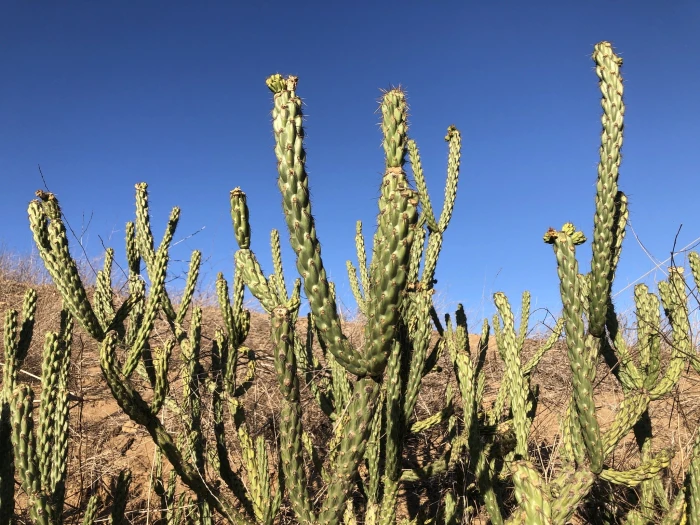Cane Cholla
(Cylindropuntia bernardina)
Cane Cholla (Cylindropuntia bernardina)
/
/

nmoorhatch
CC BY 4.0
Image By:
nmoorhatch
Recorded By:
Copyright:
CC BY 4.0
Copyright Notice:
Photo by: nmoorhatch | License Type: CC BY 4.0 | License URL: http://creativecommons.org/licenses/by/4.0/ | Rights Holder: nmoorhatch | Publisher: iNaturalist | Date Created: 2021-11-23T23:05:53Z |













Estimated Native Range
Climate Requirements for Rancho Palos Verdes, California
| This Plant | Your Site | Plant Suitability for Your Location | ||
|---|---|---|---|---|
| • Precipitation | 3" - 31" | 16" | Your precipitation may be too high for this plant. | Too high |
| • High Temp. | 73°F - 108°F | 80°F | Your summer temperatures are normal for this plant. | Excellent |
| • Low Temp. | 23°F - 48°F | 46°F | Your winter temperatures are normal for this plant | Excellent |
This plant may not grow well at your location - your precipitation is too high.
Summary
Cylindropuntia bernardina, commonly known as cane cholla or valley cholla, is a perennial cactus native to the desert scrub and chaparral of California and northwestern Baja California, particularly in the foothills of the Transverse and Peninsular Ranges, parts of the Sonoran Desert, and the Coast Ranges. It can grow up to 10 feet tall and is characterized by its segmented, cylindrical stems that bear yellow to orange-brown spines. The plant produces showy yellow flowers with green or yellow filaments during late spring to early summer, which are followed by dry, spiny fruits that persist on the plant.
Cane cholla is valued for its striking appearance and resilience in arid landscapes. It is often used in xeriscaping, rock gardens, and as a focal point in drought-tolerant plantings. This cactus requires minimal maintenance once established and thrives in full sun with well-drained soil. It is tolerant of poor soils and needs little water once established, making it an ideal choice for water-wise gardens. While it is generally free of serious pests and diseases, it can be susceptible to root rot if overwatered. Gardeners should handle it with care due to its sharp spines, and it is advisable to plant it away from high-traffic areas to avoid injury.CC BY-SA 4.0
Cane cholla is valued for its striking appearance and resilience in arid landscapes. It is often used in xeriscaping, rock gardens, and as a focal point in drought-tolerant plantings. This cactus requires minimal maintenance once established and thrives in full sun with well-drained soil. It is tolerant of poor soils and needs little water once established, making it an ideal choice for water-wise gardens. While it is generally free of serious pests and diseases, it can be susceptible to root rot if overwatered. Gardeners should handle it with care due to its sharp spines, and it is advisable to plant it away from high-traffic areas to avoid injury.CC BY-SA 4.0
Plant Description
- Plant Type: Succulent
- Height: 2-4 feet
- Width: 1-2 feet
- Growth Rate: Moderate
- Flower Color: Yellow
- Flowering Season: Spring
- Leaf Retention: Evergreen
Growth Requirements
- Sun: Full Sun
- Water: Very Low
- Drainage: Fast
Common Uses
Drought Tolerant, Low Maintenance, Rock Garden
Natural Habitat
Native to the desert scrub and chaparral of California and northwestern Baja California
Other Names
Common Names: San Bernardino Cholla
Scientific Names: Cylindropuntia bernardina, Cylindropuntia californica subsp. parkeri, Cylindropuntia californica var. parkeri, Opuntia bernardina, Opuntia bernardina, Opuntia californica var. parkeri, Opuntia echinocarpa var. parkeri, Opuntia parryi var. bernardina, Opuntia parryi var. parryi
GBIF Accepted Name: Cylindropuntia bernardina